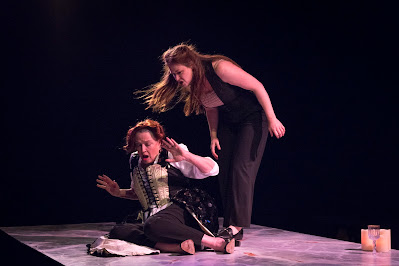Written by William Goulding
Adapted by Nigel Williams
Directed by Caitlin Baker & Lachlan Houen
Canberra REP at the Canberra REP Theatre, Acton to 10
August
Reviewed by Len Power 26 July 2024
First published in 1954, William Goulding’s “Lord Of The Flies” became a best-selling novel which has also been filmed. It’s long been a choice for reading in schools, and it remains a popular and well-known novel.
Stranded on a remote island after a plane crash, a group of English schoolboys try to govern themselves with disastrous results. The story challenges our ideas about civility and chaos as well as morality and the power of leadership.
Adapted for the stage by Nigel Williams, the play is a good choice for the dramatic opportunities it gives a young cast.
However, the decision by the directors to cast females to play male characters is distracting and confusing with most of these cast members struggling to find valid characterizations.
Only Winsome Oglivie convinced as schoolboy, Piggy. Her strong, thoughtful performance showed that gender changing can work if the actor is skilful enough to play the internal and external aspects required by the character.
Joshua James gave a good performance as Ralph, the schoolboy who tried to reason with democracy and kindness. His sensitive performance made the problems he faced more gripping and real as the play progressed.
Ty McKenzie as Jack began well but needed to find more ways to express anger as the frustration and aggression of his character grew. His continual shouting became tiresome. Characterizations of most of the cast needed more depth.
The atmospheric island set with its various acting levels and spaces, designed by Michael Sparks, should have given the directors plenty of choices for staging, but the action often seemed too restricted where it was played on the set, making it look unconvincing.
The continual drumming behind the action in the second act made it sound like an old Tarzan movie and you wondered if, maybe, there were other people on the island after all. If all the survivors were onstage, who was drumming?
The final scene with the appearance of the naval officer was melodramatic. It was never made clear when the action of the play took place and the 1950s-sounding authority of the naval officer barking commands, which the boys dutifully and silently obeyed, seemed unrealistic, producing unbelieving laughter from the audience.
This was not the strong and believable theatre experience it should have been.
Len Power's reviews are also broadcast on Artsound FM 92.7 in the ‘Arts Cafe’ and ‘Arts About’ programs and published in his blog 'Just Power Writing' at https://justpowerwriting.blogspot.com/.









.jpg)

%20Karen%20Vickery%20(B).jpg)










